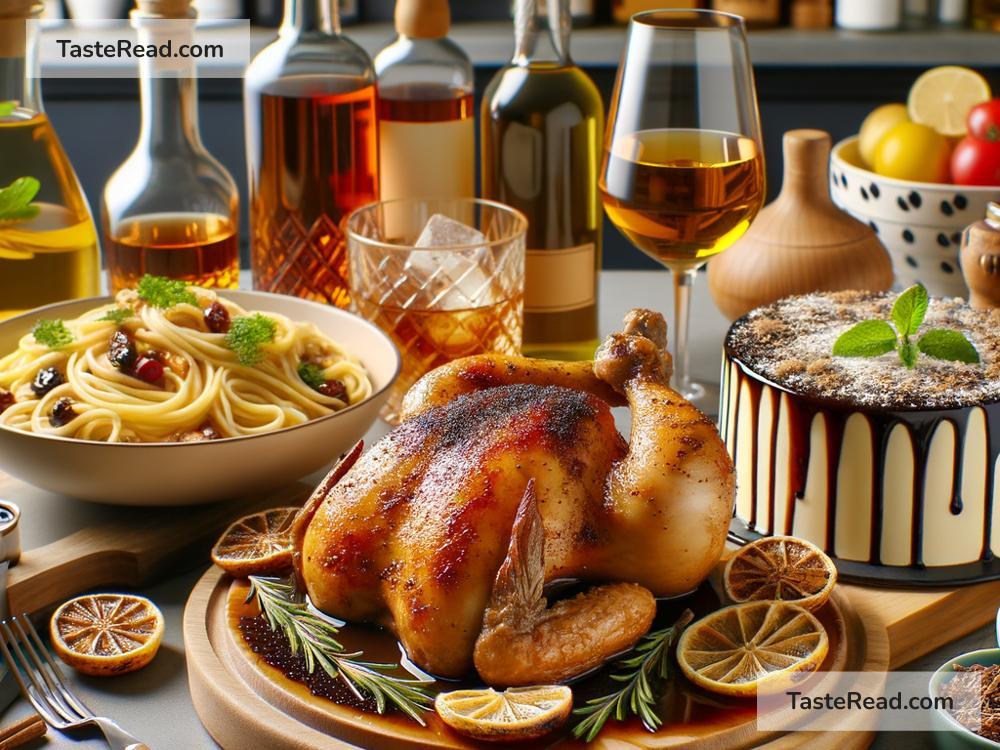The Science of Cooking with Alcohol: Techniques and Tips
Cooking with alcohol isn’t just for fancy chefs—it’s a simple and fun way to add rich flavors to your meals. Whether you’re adding wine to a sauce or using beer in a batter, alcohol can change the way your food tastes and even how it cooks. But how does it work? What are the techniques? And do you need to worry about getting tipsy from your dinner? Let’s dive into the science of cooking with alcohol and learn some helpful tips along the way.
What Happens When You Cook with Alcohol?
The key to using alcohol in cooking is understanding its dual role: flavor enhancer and chemical transformer.
-
Flavor Enhancer
Alcohol helps dissolve fats and oils in food, so it can release certain flavor molecules that water alone can’t handle. For example, wine added to a simmering stew will bring out earthy, fruity, or sour notes in the ingredients. Beer can add a nutty or malty flavor to bread, batters, and marinades. The type of alcohol you use brings its unique flavors to the dish. -
Chemical Transformer
Alcohol reacts with heat and other ingredients in your dish, altering its structure and taste. For example, when alcohol is combined with sugar in desserts, it creates deeper caramelization. In creamy sauces, alcohol can cut through richness and balance the flavors. It often acts as a bridge between acidic ingredients (like tomatoes or citrus) and fatty ones (like butter or cheese).
Does the Alcohol Cook Off?
Many people wonder if cooking with alcohol leaves any traces of it behind. The answer depends on how long and how intensely the dish is cooked.
When you heat alcohol, some of it evaporates, but not all. For example:
-
Quick cooking methods: If you flambé a dish (lighting alcohol on fire) or simply pour wine into a sauce to simmer for 5 minutes, most of the alcohol stays. Up to 85% of the alcohol can remain in the dish.
-
Long cooking methods: Baking or simmering a dish for 2+ hours will remove almost all the alcohol—only about 5% or less remains.
This is important to note if you’re cooking for people who avoid alcohol entirely or for young children. In such cases, you can substitute alcohol-free versions (like nonalcoholic beer or wine) or use similar liquids like broth, juice, or vinegar for flavor.
Common Types of Alcohol for Cooking
Different types of alcohol bring unique flavors to your dishes. Experimenting is part of the fun, but here’s a quick guide to get you started:
- Wine
- Red wine: Great for hearty dishes like beef stew, tomato sauce, and mushroom risottos. It adds depth and complexity.
-
White wine: Perfect for lighter dishes like chicken, seafood, or creamy sauces. It brings a bright, tangy flavor.
-
Beer
- Lager: Adds a light, crisp flavor—great for batter-fried fish or chicken.
-
Stout or dark beer: Brings richness, perfect for bread, chili, or braising meats.
-
Spirits
- Whiskey: Adds smoky, sweet notes to marinades, sauces, desserts, or even barbecue glazing.
- Rum: Popular in Caribbean cooking, especially for sweet recipes like cakes or bananas foster.
-
Vodka: Used for its subtle flavor—it’s great in creamy pasta dishes like vodka sauce.
-
Liqueurs
Many liqueurs, like Grand Marnier or Amaretto, are used in desserts to add fruity, nutty, or spiced flavors. They’re great in glazed cakes or creamy fillings.
Techniques for Cooking with Alcohol
Using alcohol in cooking isn’t complicated, but knowing a few techniques can make a big difference:
-
Deglazing
This is when you pour alcohol into a hot pan after you’ve browned meat or vegetables. The alcohol helps loosen the tasty stuck bits at the bottom of the pan, creating a flavorful base for sauces or soups. Wine or beer is commonly used for deglazing. -
Marinating
Alcohol helps tenderize meat and infuses flavor during marination. For example, beer or wine with herbs can make your chicken or steak extra juicy and tasty. -
Baking
Alcohol is a key ingredient in many baked goods like fruitcakes or trifles. It keeps the cake moist and provides subtle aromas. You can even soak fruits in alcohol before baking for extra flavor. -
Simmering and Braising
Add alcohol early in a slow-cooking dish to let it mellow and fuse with other flavors. For example, stew with wine-based broth develops a complex taste over time.
Tips for Cooking with Alcohol
-
Choose the right alcohol for the dish.
Bold red wines pair well with red meat and tomato-based sauces, while light spirits like vodka or white wine complement creamy dishes. -
Don’t use bad alcohol for cooking.
The saying “only cook with alcohol that you’d drink” is true! Cheap, low-quality alcohol will make your dish feel off. Choose something you’d enjoy sipping. -
Add alcohol in stages.
Adding alcohol all at once can overwhelm your dish. Start with a little, taste, and adjust. Slow cooking helps balance out its flavors. -
Be mindful of substitutions.
If you don’t want to use alcohol, try alternatives like broth, juice, or vinegar to achieve similar effects.
Final Thoughts
Cooking with alcohol opens up a whole new world of flavors. Whether you’re deglazing a pan with wine or baking a rum-soaked cake, alcohol acts as both a flavor enhancer and a scientific tool to transform your dishes. With practice and experimentation, you’ll soon master how to incorporate it into your recipes while impressing your friends and family with the tasty results. So grab that bottle of wine or beer and start cooking—your kitchen is about to become a chemistry lab for flavors!


